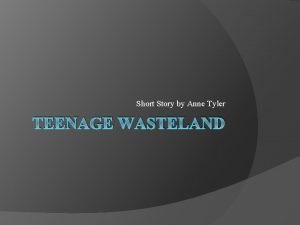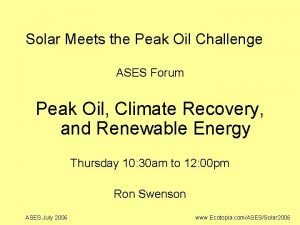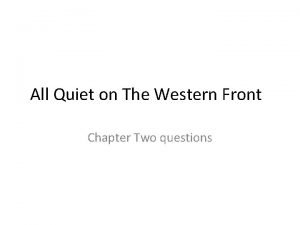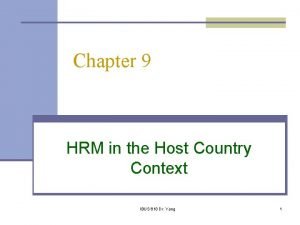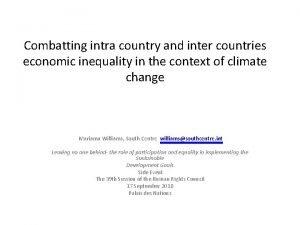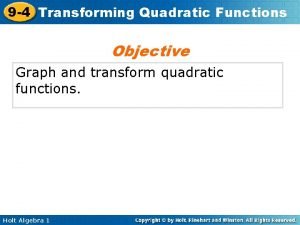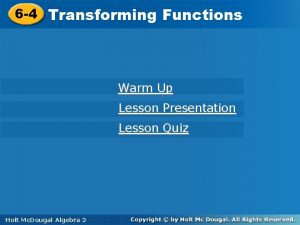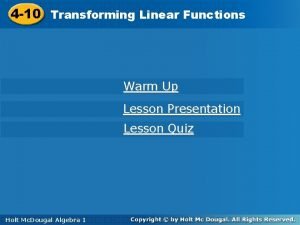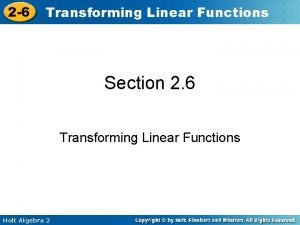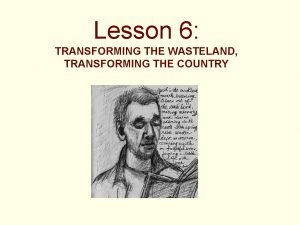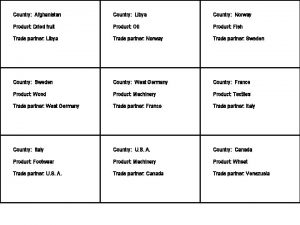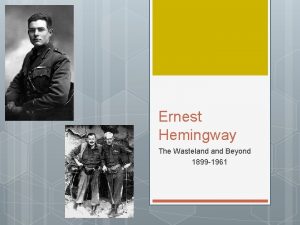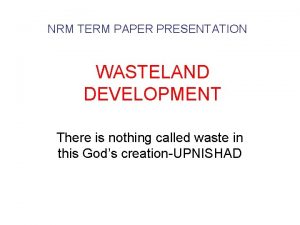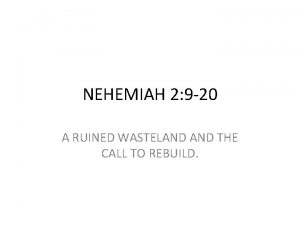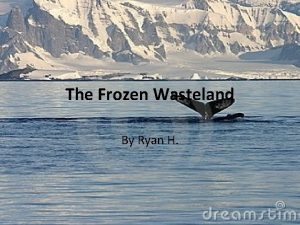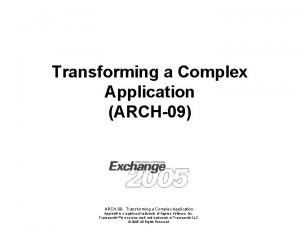Lesson 6 TRANSFORMING THE WASTELAND TRANSFORMING THE COUNTRY
















































- Slides: 48

Lesson 6: TRANSFORMING THE WASTELAND, TRANSFORMING THE COUNTRY

In This Lecture • PART ONE: Dawn of a “New” Era • PART TWO: Camelot • PART THREE: The Wasteland Revised • The Link: changing times, changing media.

PART ONE: Dawn of a “New” Era • As the 1950 s came to an end, a brave-if not entirely “new”--world was just around the corner.

Atomic Cafe • (pause lecture. Under Learning Tasks view Atomic Cafe. This documentary is based on archival footage from the 1940 s, 50 s and 60 s and is about the fear of nuclear warfare during the cold war. Consider how these media narratives both perpetuate and mitigate cold war paranoia. )

Show it. Don’t Say it. What is unique about the structure of Atomic Cafe? • No narrative. • No interviews. • Atomic Cafe derives its narrative power entirely by juxtaposing bits of stock footage.

Term: “juxtaposition” • • “to place close together, or side-by-side, for comparison or contrast. ” the mass-media generates countless juxtaposition. note similarity to “paradox” (side-by-side beliefs. ) Mass-media creates meaning ironically.

Term: “irony” • • 1. an intention or attitude opposite to that which is actually stated. 2. a manner of organizing a work so as to give full expression to contradictory or complementary impulses, attitudes, etc. , esp. as a means of indicating detachment from a subject, theme, or emotion.

How is Atomic Cafe ironic? Opposite intent: upbeat footage originally intended to assure people that we can survive nuclear attack, now seems comical and sadly absurd. Organized to reveal contradictions: juxtaposition of supposedly objective instructional movies reveals hidden biases and self-delusion.

A New Hope • As the cold war continued to grip the country, Americans were longing for a more hopeful, optimistic future. • As the first generation raised on TV began to mature, all sorts of cultural norms were challenged.

Term: “norm” • Social “norm” - coined by Émile Durkheim, the father of modern sociology. • the dominant, or “hegemonic” subject position in a particular society. • Models the behavior of everyone, even those not in dominant positions.

Term: “hegemony” • • Hegemony is the dominant perspective in a specific cultural context. It dictates the norms. In this course we will be discussing hegemony in terms of different eras in U. S. history. When is Tony Soprano conforming to U. S. hegemony? When he commits crimes? Or when he buys a house in the suburbs? It depends on how you construct your argument. A class-based argument would see his criminal behavior as outside of the norms. However, an argument about the U. S. fascination with the “outlaw individual” might locate his behavior inside a different sort of “normative” frame.

Traditional hegemonic norms in U. S. • gender - favoring male patriarch • race - whiteness • class - middle-class values (at least in terms of cultural representation, though not necessarily institutional power)

Norms vs. stereotypes • • • Norms can be stereotypes (i. e. Suzy Homemaker) But stereotypes are NOT always norms (i. e. angry feminist) Elaboration: “angry feminist” is a stereotype constructed by a patriarchal (male dominated) culture, but NOT a norm. In a male dominated culture, women are not “supposed” to be feminists, angry or otherwise. Thus, being a feminist of any kind is not considered a social “norm. ” Norms always represent what the hegemonic (dominant) cultural force (in this case, patriarchy) says we should aspire to become. Thus the happy domestic goddess (Suzy Homemaker) is both a stereotype and a norm. She is both constructed by and celebrated by patriarchal culture. She is the “norm” that other woman are supposed to aspire to emulate (as opposed to the angry feminist).

Norms are unstable • • What is considered “normal” behavior is in constant flux. The media both maintains and subverts norms. Norms are also in competition with each other. Example: Sex in the City. Subverts norms about domesticated women. Maintains norms of women obsessed with fashion and shopping. This norm is in competition with the norm of the self-sufficient individual (male and female).

It’s Never to Late to Deviate, Norms Under Siege: 50’s Conformity Gives way to 60 s nonconformity From the very start, the 1960 s looked like a very different decade than the 1950 s. • • • 50 s culture championed domesticity. 60 s culture championed youthful self-expression. The baby boomers were coming of age.

1960: • • • John F. Kennedy elected youngest president ever, suggests idea of Peace Corps. FDA approves birth control pill, setting the stage for sexual revolution. Timothy Leary tries psilocybin mushrooms for the first time, setting the stage for “psychedelic sixties. ” First nonviolent protests (sit-ins) by blacks in the South, setting stage for a more effective Civil Rights movement. Penguin Books is found not guilty of obscenity in the Lady Chatterley’s Lover case, a revision of traditional censorship laws.

What Role Would Television Play? • As the new era dawned, television was selling all sorts of new products, even a new president.

Kennedy/Nixon Debate • (pause lecture. Under Learning Tasks view “Kennedy/Nixon Debate. ” The 1960 presidential debate. Some say this TV broadcast cost Nixon the election. )

Reaction to the Debate • • • More radio listeners thought Nixon won. More TV viewers thought Kennedy won. On camera, Nixon looked tired and less appealing. Kennedy looked fresh-faced and “telegenic. ” Television had become a powerful force in American politics.

• • Questions: Did television get JFK elected? Was he our first “TV president? ” Footage of Kennedy’s death was also televised? How did this effect his legacy? Does TV favor innovation over tradition, young over old? Style over substance? Politicians, newscasters and even country music stars are much younger and more attractive now than they were in the early days of television. What influence does this have on popular culture?

PART TWO: Camelot Rising • From the start, the Kennedy Presidency took on a romantic, fairy tale aura. • The two people who most embodied this aura were the President and his first lady, Jacqueline Kennedy.

Meet the First Lady • (pause lecture. Under Learning Tasks view “A Tour of the Whitehouse. ”)

Term: Text • Any media product: a TV show, a film, a book, a comic book, a song, etc.

Term: Textual Analysis • Essays for FMS 300 should include textual analysis: a close reading of sounds and images supporting a central thesis.

Thesis • The white house tour reflects a tension between two images of Jacqueline Kennedy: the representative of youth and innovation and the defender of traditional values. Via “textual analysis, ” we will explore the ways that the television “text” constructs these “competing Jackies”. . .

Innovation • Jacqueline models a hairstyle popular with young women at the time. • We learn of her interest in remodeling and refurbishing the old building.

Tradition • • • She demonstrates an appreciation of and detailed knowledge about antique furniture. Like Donna Reed, she is depicted as the Queen of the domestic sphere, an expert on all things domestic. She evades the one political question about whether husband’s administration should fund the arts. “It’s all so complicated. ” She is first framed in a wide shot revealing the grandeur of her elegant surroundings. Her movements are slow and calculated and her voice carefully modulated, the results of a finishing school education. The camera is either static or smoothly tracking her, creating a sense of stability and polish.

Innovation & Tradition • She favors furniture reflecting the new world, rather than Europe. (newer aesthetic, but also traditional value of patriotism)

Term: Nuance • • Contrast: Single perspective essay (I like Star Wars because. . . ) A nuanced critic is not one-sided. It may emphasize one perspective, while still acknowledging opposing views. Or it may represent opposing views as relatively equal.

Questions Fighting Nuance: • • • Why was Jacqueline the best first lady ever? Why was everyone so fascinated with Jacqueline Kennedy? Why was Jacqueline Kennedy’s tour of the white house extremely boring?

Questions Inviting Nuance: • • • How is Jacqueline both a step forward and a throwback for women? A stylish new type of first lady and a Stepford Wife? How is her public image different than that of our current first lady? Why is this? What role did television play in constructing the myth of “Camelot? ” And how did the myth of Camelot change television?

PART THREE: The Wasteland Revised

Sir Newton vs. the Boob Tube Barbarians • One of Camelot’s most powerful and self-righteous knights was FCC chairman Newton Minnow. • He crusaded to change the face of television entirely. • Though he only partly succeeded, he did shake things up a bit.

Newton Minow • • (b. 1926) In a speech given to the National Association of Broadcasters convention on May 9, 1961, called TV a “Vast Wasteland, ” not because it was dull, but because it lacked intellectual substance. The S. S. Minnow of the 1964– 1967 television show “Gilligan’s Island” was sarcastically named for him. He persuaded Congress to pass legislation clearing the way for communications satellites. He created the All Channels Act (1961), which mandated UHF reception capability for all television sets sold in the U. S. This generated more television stations and non-profit educational television stations (now PBS)

Questioning Minow • • He says history will decided whether “broadcasters employed their powerful voice to enrich people or debase them. ” Fifty years later, what do we think? He defines “public interest” as more than what “interests the public. ” So what is it exactly? He describes situation comedies and quiz shows as innately trivial. Can we think of exceptions to this view? He says that “the people are wiser than some of the broadcasters think. ” And that TV needs to improve or risk losing its audience. Did this turn out to be true?

Questioning Minow (cont’d) • • He thinks UHF will give more people ability to create and broadcast media. Did the experiment work? How is UHF related to public access cable and the Internet? He is opposed to government censorship, yet the FCC wields influence. How? In regards to satellites, Minow wonders, “What will the people of other countries think of us when they see our programming? ” How has American media shaped the world’s view of our culture? He says he believes that most of problems are due to lack of competition. Have more choices improved quality overall?

“Indiana Murrow” and the Last Crusade • 1960: Edward R. Murrow (See it Now) presents his last great television expose. • “Harvest of Shame” for CBS Reports.

Harvest of Shame • • • Six months before Newton Minow gave his “wasteland speech, CBS Reports broadcast a show that demonstrated television’s potential to shed light on important issues. “Harvest of Shame” was a report on the plight of migrant farm workers. The shows was created by Edward R. Murrow and Fred Friendly, who had challenged Mc. Carthyism on See it Now.

“Thanks for the corn and the potatoes and, oh. . . for not having to harvest them. ” • Broadcast the day after Thanksgiving, “Harvest of Shame” drew a stark contrast between Americans with much to be thankful for and the under privileged multitudes who worked to provide them with food.

Go to “Harvest of Shame” • (pause lecture. Under Learning Tasks view “Harvest of Shame. ” This episode of CBS Reports focuses on migrant farm workers. )

Postscript • • • “Harvest of Shame” was Murrow’s final documentary for CBS. In 1961, he left the network to become the head of the United States Information Agency at President Kennedy’s request. The Agency provided the official views of the U. S. government to other nations.

Edward R. Murrow (1908 -1965) • In 1965, Murrow, a heavy smoker, died of lung cancer.

Going with the Flow • • • In the 1960 s television became more than escapism. It brought us images of the war in Vietnam, student protests, the civil rights movement and the growing counterculture. By the 1970 s, examining the medium’s growing sense of social awareness demanded a new type of media theory, one that emphasized social influences.

Raymond Williams (1921 -1988) • Welsh media theorist • Outspoken critic of Mc. Luhan • social construction • Sequence and Flow - economic imperatives shape the structure of TV programming.

Sequence and Flow • • • “Flow” is how television networks try to hold the attention of the audience and lead them from one program to another. “Sequence” units of flow larger than individual programs (like sections of a novel, comprised of smaller chapters). Williams is British and in the 1970 s, when he visited America, he was struck by the amount of attention paid to flow in U. S. TV.

Questions: • In the post-Tivo, digital age - is William’s concept of programming flow increasingly outdated? • Or is it simply taking on new implications regarding the flow of interactive media?

Contemporary Forms of “Flow” • webisodes (serialized) • Internet links • Twitter “Follow Friday” • RSS feeds • Social bookmarking (Digg, Delicious) • Custom recommendation (Pandora)

Next Time: COLD WARRIOR TV/CAMELOT TV (PART ONE)
 Wasteland background
Wasteland background Pasteurization of milk
Pasteurization of milk Peak oil forum
Peak oil forum Nuclear wasteland
Nuclear wasteland All quiet on the western front chapter 2
All quiet on the western front chapter 2 Host country and home country
Host country and home country Intra country vs inter country
Intra country vs inter country Transformation of linear functions
Transformation of linear functions Which of the quadratic functions has the narrowest graph
Which of the quadratic functions has the narrowest graph Transforming polynomial functions quiz
Transforming polynomial functions quiz Transforming linear functions lesson 6-4
Transforming linear functions lesson 6-4 Lesson 4-10 transforming linear functions answers
Lesson 4-10 transforming linear functions answers Writing functions
Writing functions 3-3 lesson quiz transforming linear functions
3-3 lesson quiz transforming linear functions Lesson 6-2 transforming quadratic functions
Lesson 6-2 transforming quadratic functions Linear function transformations
Linear function transformations Transforming linear functions lesson 6-4
Transforming linear functions lesson 6-4 Lesson 6-4 transforming linear functions
Lesson 6-4 transforming linear functions Lesson 11 transforming the graph of the sine function
Lesson 11 transforming the graph of the sine function Hình ảnh bộ gõ cơ thể búng tay
Hình ảnh bộ gõ cơ thể búng tay Ng-html
Ng-html Bổ thể
Bổ thể Tỉ lệ cơ thể trẻ em
Tỉ lệ cơ thể trẻ em Gấu đi như thế nào
Gấu đi như thế nào Tư thế worm breton
Tư thế worm breton Chúa sống lại
Chúa sống lại Các môn thể thao bắt đầu bằng từ đua
Các môn thể thao bắt đầu bằng từ đua Thế nào là hệ số cao nhất
Thế nào là hệ số cao nhất Các châu lục và đại dương trên thế giới
Các châu lục và đại dương trên thế giới Công của trọng lực
Công của trọng lực Trời xanh đây là của chúng ta thể thơ
Trời xanh đây là của chúng ta thể thơ Mật thư tọa độ 5x5
Mật thư tọa độ 5x5 Phép trừ bù
Phép trừ bù độ dài liên kết
độ dài liên kết Các châu lục và đại dương trên thế giới
Các châu lục và đại dương trên thế giới Thể thơ truyền thống
Thể thơ truyền thống Quá trình desamine hóa có thể tạo ra
Quá trình desamine hóa có thể tạo ra Một số thể thơ truyền thống
Một số thể thơ truyền thống Cái miệng xinh xinh thế chỉ nói điều hay thôi
Cái miệng xinh xinh thế chỉ nói điều hay thôi Vẽ hình chiếu vuông góc của vật thể sau
Vẽ hình chiếu vuông góc của vật thể sau Nguyên nhân của sự mỏi cơ sinh 8
Nguyên nhân của sự mỏi cơ sinh 8 đặc điểm cơ thể của người tối cổ
đặc điểm cơ thể của người tối cổ V cc
V cc Vẽ hình chiếu đứng bằng cạnh của vật thể
Vẽ hình chiếu đứng bằng cạnh của vật thể Phối cảnh
Phối cảnh Thẻ vin
Thẻ vin đại từ thay thế
đại từ thay thế điện thế nghỉ
điện thế nghỉ Tư thế ngồi viết
Tư thế ngồi viết
